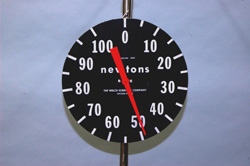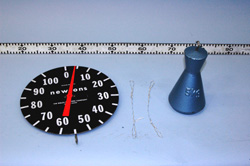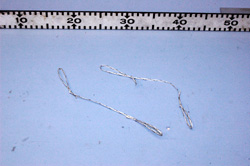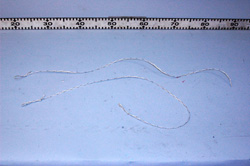Tension in a String, 1J30.20
Topic and Concept:
Statistics of Rigid Bodies, 1J30. Resolution of Forces
Location:
Cabinet: Mechanic (ME)
Bay: (B2)
Shelf: #1
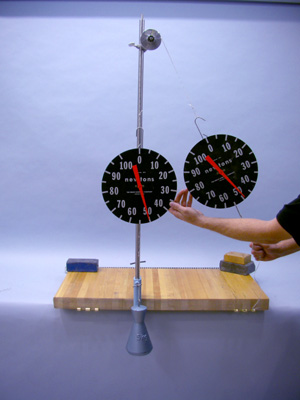
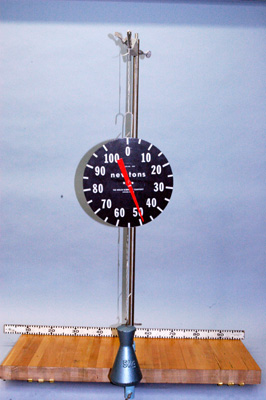
Abstract:
Two spring scales are used to show that the tension within a string attached to a hanging mass is the same on both sided of a pulley, then shown as a static free-body example with one spring scale.
Equipment |
Location |
ID Number |
|
|
|
Newton Scale |
ME, Bay B2, Shelf #1 |
|
3 Strings (1 Long, 2 Short) |
ME, Bay B1, Shelf #2 |
|
5 kg Weight |
ME, Bay B1, Shelf #2 |
|
Important Setup Notes:
- N/A
Setup and Procedure:
Part A:
- Fasten the rod/clamp setup with the cantilevered pulley to the lecture bench.
- Hang the two spring scales from the pulley by hooking each scale on either end of the longer string (see photos).
- From one of the suspended spring scales, hang the 5 kg mass with one of the shorter strings.
- Hold on to the bottom hook of the other spring scales that the string remains taught (see photos) - the readings on the two scales should be the same (ignoring friction and the mass of the pulley).
- The force reading on the spring scales is the tension in the string.
Part B:
- Keep the rod/clamp setup as is in part A.
- If needed, take out the 5 kg mass from the system to make reconfiguring easier.
- Take out the scales and pick just one to be used.
- Hang this scale from the cantilever portion of the pulley, using one of the shorter strings.
- Now suspend the 5 kg mass from the scale using the other short string.
Cautions, Warnings, or Safety Concerns:
- N/A
Discussion:
When a string is taught, there is force along the string that is constant. It acts to oppose further increases in tension which arises, fundamentally, from the net attractive force between the atoms making up the material when the material is deformed. The magnitude of this force is the sum of the magnitudes of the forces pulling on the string which act to deform the string.
In part A of this demonstration, the strings provide a tension T = m*g where m is the 5 kg mass and g is the acceleration due to gravity 9.81 m s-2 . In other words, the tension is equal to the weight of the mass. When the taught string is run over the pulley, the tension force is effectively rerouted (the direction is changed). The scales don't change this tension (at least not much - they do have a little weight). This is apparent since if the tension was different on either side of the scale, there would be a net acceleration which is not the case. Thus, each scale can be regarded as part of the string, and they display the magnitude of the tension at their respective point in the string.
One might notice the slight disagreement of the two scales in the magnitude of the tension. The scale on the opposite side of the pulley relative to the mass displays a slightly smaller reading. This is due to the friction in the bearings of the pulley and the moment of inertia of the pulley.
|
|
|
|
|
Videos:
References:

